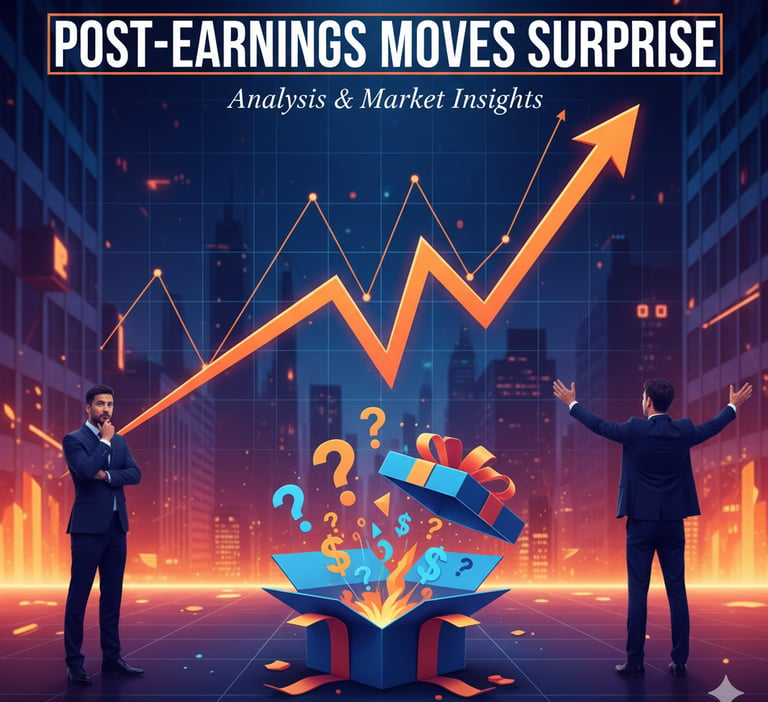Why Post-Earnings Moves Are Wilder Today What Investors Should Know
FUNDAMENTAL
Yohanes Wahyudi
2 min read


Earnings season has always been a catalyst for price volatility. But if you feel like post-earnings swings are sharper today than they used to be, you’re not imagining it. Recent academic research and market data confirm that earnings-day moves have become both larger and less predictable compared with the pre-2020 period. For active investors, this shift has implications for risk management, options trading, and portfolio positioning.
The Historical Baseline: Contained but Predictable
From 2010–2019, large-cap U.S. stocks typically moved around 3–4% on earnings day. A study by the American Economic Association reports that average announcement-day drifts in this period were roughly +2.46% for positive surprises and –2.51% for negative surprises, with volatilities relatively muted compared with today’s levels.
This stability was supported by deep liquidity, systematic volatility selling, and corporate buybacks that often dampened price swings outside of blackout periods.
The Pandemic Shock: Volatility Repricing
The arrival of COVID-19 marked a sharp break from this pattern. A 2023 study in Emerging Markets Finance and Trade finds that the pandemic acted as an “exogenous shock” to investor behavior, leading to significantly larger earnings-day returns and higher uncertainty.
Empirically, the median absolute move rose to ~6% during 2020–2021, nearly double the pre-2020 norm. This was driven by:
Unprecedented uncertainty about demand and supply chains
A surge in retail trading and option activity
Lower liquidity in single stocks, which magnified order-flow imbalances
The Post-Pandemic Era: Elevated but Not Extreme
Volatility has moderated since the 2020–2021 peak, but earnings reactions remain structurally higher than a decade ago. A Philadelphia Fed working paper finds that average abnormal returns around earnings remain elevated, with absolute one-day moves closer to 4.5–5% in recent years.
Technology and healthcare stocks have shown particularly outsized reactions, reflecting both higher growth expectations and greater sensitivity to macro policy (e.g., rates, regulation, drug pricing).
Looking ahead, geopolitical tensions and trade policies (particularly tariff escalations) are likely to add another layer of earnings-season volatility. Companies with global supply chains may face amplified uncertainty around costs and revenues, and the market’s reaction to earnings will increasingly reflect not only company fundamentals but also the shifting geopolitical backdrop. For investors, this means that even routine earnings announcements can become flashpoints for much larger moves when overlaid with policy shocks.
Why This Matters for Investors
1. Option Strategies Require Adjustment
Pre-2020, earnings straddles were often overpriced relative to realized moves. Today, implied volatilities are more aligned with realized earnings volatility, making “selling vol” less consistently profitable.
2. Portfolio Risk Management
Investors who size positions based on historical volatilities risk underestimating today’s event risk. A 4% average move vs. 6% may not sound dramatic, but compounded across dozens of positions, it significantly alters portfolio drawdown potential.
3. Sector Differentiation
Mega-cap tech earnings can now swing indices. Apple and Meta have both delivered ±10% post-earnings moves since 2022 which is something almost unthinkable for trillion-dollar companies pre-2020. Active managers must account for these “macro-via-micro” shocks.
Earnings are no longer the steady, incremental catalyst they once were. For modern investors, post-earnings volatility is structurally higher than pre-2020 — a legacy of the pandemic, shifting market structure, and amplified option activity.
And with geopolitical and tariff risks set to play a bigger role, investors should brace for earnings reactions that increasingly blend fundamentals with policy-driven uncertainty. Risk models, trade sizing, and event-driven strategies must be recalibrated accordingly.
Sources:
American Economic Association working paper on earnings announcement returns (2010–2021 sample).
“Using the COVID-19 pandemic as an exogenous shock: how investors react to corporate earnings announcements,” Emerging Markets Finance and Trade (2023).
Federal Reserve Bank of Philadelphia working paper: “PEAD.txt: Post-Earnings-Announcement Drift Using Text.”
Financial Times, “Corporate earnings now drive double-digit index moves more frequently” (2024 reporting).
Quantamental Investing
info@thirdfactorcapital.com
+1 347-566-0840
© 2025. Third Factor Capital. All rights reserved.
Combining Quantitative and Fundamental Insights
